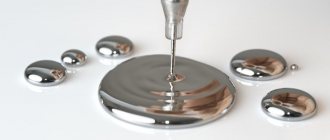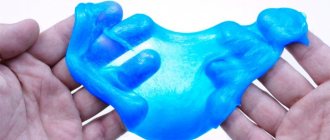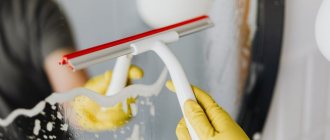Demercurization is the removal of mercury particles from a contaminated area. If thermometers or mercury lamps are damaged, household leakage of mercury drops occurs. In room conditions, mercury is in a liquid state and forms silvery drops. In the room where the leak occurred, mercury vapor spreads. It is necessary to carry out demercurization - the process of neutralizing mercury. It is possible to eliminate the consequences of a leak yourself or by contacting the Ministry of Emergency Situations.
Have you ever broken a thermometer?
Not really
What is demercurization?
Mercury is classified as a highly hazardous transfer metal. When inhaling mercury vapor, human poisoning occurs. Symptoms of poisoning:
- Weakness, dizziness, headaches.
- Significant increase in body temperature.
- Bleeding gums, metallic taste.
- Decreased appetite.
- Painful sensations in the abdominal area, vomiting.
- Chest pain.
- Shiver.
Lack of measures to eliminate mercury droplets leads to severe mercury vapor poisoning. In some cases, the victims may die. If there are signs of poisoning, you need to call an ambulance and induce vomiting in the victim.
There are industrial and household demercurization.
At home, physical demercurization methods are used without the use of chemicals. In the event of a mercury spill at industrial enterprises, special chemicals are used to neutralize the premises.
The main sources of the spread of hazardous metal in private homes are medical thermometers and mercury lamps. Damage to these devices requires immediate action to eliminate mercury contamination. If there is a large area of mercury on your home property, it is necessary to call specialists and carry out chemical treatment.
Brief information about mercury and its properties
Mercury (Hg) has been known for a long time.
This heavy metal belongs to the first class of hazardous substances and is quite rare.
Mercury is a silvery-white metal in a liquid aggregate state under normal conditions; it is insoluble in water without impurities. There are about 20 mercury minerals found in nature, the most common being cinnabar (HgS).
Mercury is extremely rarely found in its native form in nature. The heavy metal is obtained by burning (heating) minerals, in particular cinnabar. Mercury vapor condenses and mercury is formed.
The use of mercury has been found in medicine. The metal is used for the preservation of vaccines, as well as for the production of devices for measuring body temperature - thermometers. In addition, mercury is used in the production of fluorescent light bulbs, which help significantly reduce energy consumption.
The metal is used to produce equipment and parts that are quite rarely found in everyday life - specialized mercury valves, sealed switches, position sensors and other devices.
Like any liquid substance, mercury evaporates at room temperature. Mercury vapor poses a very dangerous threat to human health.
Prolonged inhalation of toxic mercury vapor leads to damage to the central nervous system, damage to the excretory system and death.
It is very important to quickly and carefully take measures to eliminate metal leaks.
The procedure for working with mercury-containing devices in healthcare institutions The procedure for using mercury devices is established by sanitary rules, norms and methodological recommendations.
An appointed person must monitor compliance with the order (sample order). The responsibilities of the responsible person include: collecting and storing devices that have lost their functions, organizing the removal of mercury in emergency situations, as well as transferring used devices to a specialized enterprise for disposal.
Appointed persons are required to undergo a medical examination and training every year. Consolidation and delivery of unusable devices containing mercury must be carried out without fail.
How to get rid of mercury at home?
Demercurization of mercury at home requires preparatory actions:
- Removing children and adults present in the contaminated area to a safe place.
- Opening windows to ventilate the room. In winter, using ventilation, you should reduce the room temperature to 15 degrees.
- Dressing in clothes made of synthetic material.
- To protect the skin of your hands, you must wear rubber gloves. It is recommended to wear shoe covers on shoes and use a gauze bandage to protect the respiratory tract.
- Place fabric items that may have been exposed to mercury particles in plastic bags outside or on a loggia. Carpet that has been exposed to drops of mercury must be disposed of.
Directly for demercurization, you need to prepare tools: a glass jar with a lid, tape, a rubber bulb, a flashlight.
Independent demercurization of the premises must be carried out in strict accordance with the instructions. Mercury balls are collected from the floor using tape or newsprint soaked in vegetable oil (the metal sticks to the oily surface). After collection, the balls are placed in a jar of water, which must be closed with a tight lid.
Mercury droplets are able to penetrate small cracks. Cracks in floor coverings should be carefully treated.
How else can you quickly remove the remains of a broken fluorescent lamp?
To efficiently remove small fragments, you can use stationery tape, gluing sticky strips to the place where the light bulb was broken. The glue collects glass well, which is invisible to the human eye due to its small size, and also glues remaining mercury, which increases the quality of assembly. There is no need to call a special service for demercurization. Because a small mercury content will not lead to a global environmental disaster.
The mercury content in fluorescent lamps depends on their power and is 0.1-0.5 grams. If mercury from a broken thermometer in the form of balls is relatively easy to collect, then with its vapors everything is much more complicated. And, although the contents of the flask are not fatal to humans, nevertheless, there is a very real danger of poisoning. When a fluorescent lamp breaks, the very first action to neutralize harmful substances is to ventilate the room. Due to this, the concentration of mercury vapor is noticeably reduced, the main thing is that this procedure is carried out in a timely manner.
After complete removal of particles, it is necessary to treat all surfaces with a special solution, which can reduce the concentration of vapors. It is permissible to prepare the solution yourself. Preparation in three ways is possible: 2 grams of manganese are dissolved in a liter of water; for 10 liters add 400 grams of soda and part of liquid soap; Dissolve 100 ml of iodine in a liter of water. This procedure takes 3–4 days. The resulting composition is applied to the affected area and left for 6-8 hours. Particular attention should be paid to the cracks between the floorboards, where mercury could roll in and the phosphor could spill out. There is no need to spare the solution - our health depends on the quality of demercurization.
It is necessary to treat the surface with a solution that can be prepared from available ingredients
What is an overcurrent circuit breaker and how to choose one
Demercurization in health care facilities
Elimination of the consequences of mercury leaks in medical institutions is carried out according to current instructions and in accordance with the rules. The institution appoints a responsible person who is responsible for safety measures regarding mercury-containing items and is familiar with the algorithm of actions in case of mercury leakage in health care facilities.
For minor leaks, demercurizers are used - chemical solutions to destroy traces of mercury. Demercurization kits include personal protective equipment, ingredients for creating a solution, and two containers.
Broken thermometers are placed in a container with solution and handed over to the head nurse. The room in which the mercury leak occurred is ventilated. Wet cleaning is organized.
Damaged thermometers are classified as class G waste. If there is a large leak in a health facility, it is necessary to call a special service - chemical or thermal demercurization may be required.
Safety requirements when performing work
Demercurization of the premises must be carried out by persons appointed by order of the manager who have undergone instructions.
Persons who have strictly reached 18 years of age are allowed to participate in the liquidation procedure.
Work to eliminate mercury contamination should be carried out wearing rubber gloves, shoe covers, and a respiratory mask. For prevention, it is necessary to rinse your mouth with a weak solution of potassium permanganate after finishing cleaning up the mercury leak.
Demercurization with potassium permanganate
After disposing of mercury balls, it is necessary to treat the contaminated room. Treatment with potassium permanganate allows you to get rid of the consequences of leaks at home.
The potassium permanganate solution should be dark purple in color. Add salt and vinegar to the container with the solution at the rate of 1 tablespoon per liter of liquid. The resulting solution is distributed to the places where mercury enters using a spray bottle.
After applying the solution, leave the room for one and a half hours. Then mix 50 grams of soda and 40 grams of soap shavings in 1 liter of water. Treat the areas where potassium permanganate is applied with soap and soda liquid. The procedure in combination with ventilation must be carried out a week after the mercury leak.
PERFORM ALL ACTIONS
EXTREMELY CAREFULLY, SELOWLY and CAREFULLY! -Collect the thermometer in a jar. -Using a moistened cotton swab (replacing it) move the shiny balls (mercury) onto two sheets of paper. -Place them in a jar. - Thoroughly inspect the entire room: baseboards, cracks, paths, carpets, parquet. Collect all escaped mercury. -Close the jar and place it away from heat. For example, on the balcony in the cold season. -Treat all places that came into contact with mercury balls with a solution of bleach or potassium permanganate. -Through a specialist from the Ministry of Emergency Situations, hand over for disposal: -a jar of mercury; - clothes and everything they were wearing (pre-packed in a bag); - the remaining solution and products after treatment.
Demercurization of sulfur
Previously, sulfur powder was used to eliminate the consequences of damage to mercury-containing objects. According to the results of studies, sulfur does not react with mercury under room conditions - the dangerous metal quickly evaporates, and the formation of mercury sulfide, which is harmless to humans, does not occur.
For the reaction between these elements to occur, an increase in air temperature above 200 degrees is required.
Such heating of mercury balls at home will increase the harmful effect of the metal and accelerate the formation of vapors, therefore the method of demercurization with sulfur is ineffective. There is a high probability of causing additional damage and saturation of the air with mercury vapor.
Demercurization with bleach
It is effective to clean mercury traces in a home using chlorine-containing products (household bleach). For 5 liters of water, 1 liter of product is used. The solution is diluted in a plastic container.
Places where mercury spreads are wiped with the solution using a sponge. It is necessary to treat cracks, slits, and hard-to-reach areas. The room should be ventilated during treatment. The solution is washed off with water 15 minutes after application.
The procedure must be repeated daily for a month. Sponges and buckets retain traces of mercury after the first solutions - you need to take the used items and the remaining solution for disposal to the Ministry of Emergency Situations.
Removing mercury contamination using a demercurization kit
Services providing demercurization services use demercurization kits. According to Sanpin standards, such kits are required for storage and use in institutions that use mercury-containing items.
The set includes the E-2000+ product, personal protective equipment, and materials for the procedure. The kit is designed to eliminate mercury traces over an area of up to 5 square meters.
The use of a demercurization kit allows you to cope with the consequences of a single leak of a small amount of mercury. The chemicals included in the kit are safe for humans - in rare cases, it is allowed to use the demercurizer without gloves or other protective equipment.
Purpose
Demercurization kits are special kits that include preparations and materials that can be used to perform local cleaning of mercury contamination. These kits allow you to identify and neutralize the effects of mercury in rooms where a mercury-containing lamp, thermometer, or other instrument or device containing mercury has been destroyed. These types of kits are produced in accordance with the standards specified in the technical specifications TU-2154-001-52199488-2011.
The use of such bags will allow timely neutralization of the harmful effects of mercury and avoid poisoning of people and animals.











